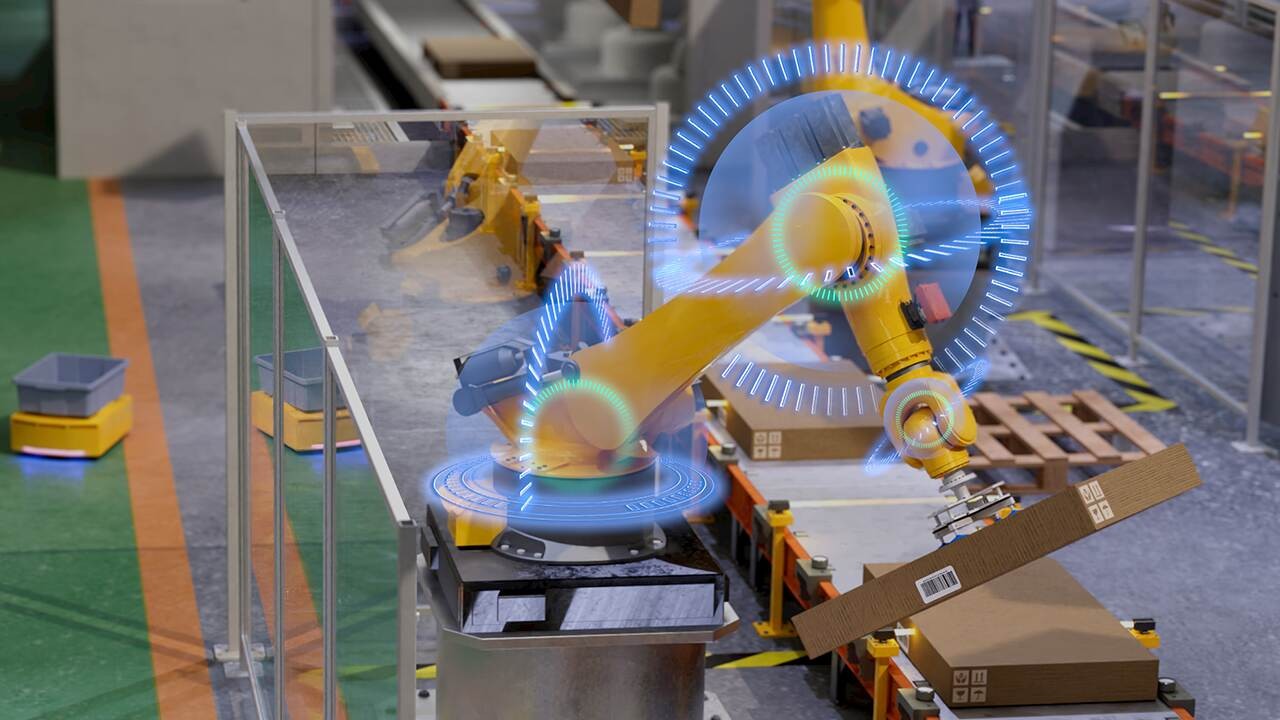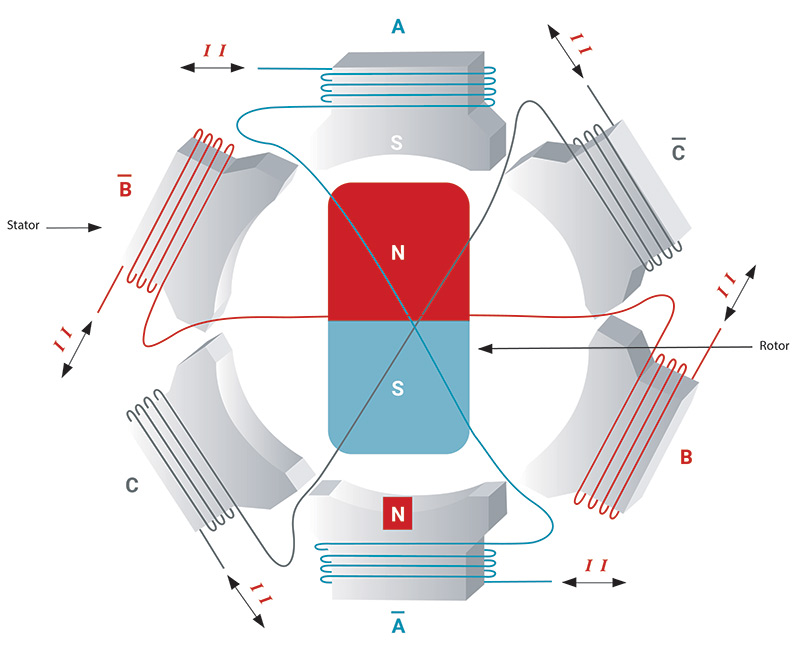SSZTCZ3 September 2023 DRV8353F , LMG3422R050 , MCT8316A , TMS320F28065 , TMS320F28P650DK
- 1
-
2
- 3
- Video: See how TI is enhancing robotics with innovative semiconductors
- How motors are driving the next generation of robotics
- Challenge No. 1: Increased safety requirements to enable human-robot collaboration
- Challenge No. 2: Reducing weight, cabling and cost through a decentralized motor architecture
- Challenge No. 3: Higher precision and accuracy to automate precise motion tasks
- Challenge No. 4: Power-efficiency optimization to enable battery-powered mobile applications
- What’s next for motor control?

From surgical procedures to lifting thousands of kilos in manufacturing plants, robots simplify many aspects of our lives. And while the impact that robots have in our modern world may be obvious, have you ever wondered how robotic systems achieve such impressively precise, fast and powerful motions? If your answer was motors, you would be correct!
A robot often replicates actions that would otherwise be performed by a human; for that reason, its capabilities will include some form of displacement or rotation to adjust position and orientation –movement typically achieved with motors.
With traditional use cases fixating on mechanical actuation such as arm maneuvering or conveyor belt cycling, modern use cases are as simple as rotating a camera or mechanical beam steering lidar sensor. You may be surprised to discover that basic fans and pumps are fundamental applications of motors that are actually very useful for cooling and hydraulics.
Video: See how TI is enhancing robotics with innovative semiconductors
For example, a brushless-DC (BLDC) motor (as shown in Figure 1) in a robotic arm joint tends to involve a rotor that rotates and a stator that remains stationary. Applying electrical signals to energize the coil windings on the stator produces magnetic fields, resulting in magnetic forces that cause the rotor to move – thus rotating the joint within the robotic arm. Use these electrical signals in the right way, and your robotic arm won’t just move – it can move with specific speed, positional accuracy and torque.
 Figure 1 BLDC motor construction cross
section diagram
Figure 1 BLDC motor construction cross
section diagramHow motors are driving the next generation of robotics
Beyond precise and powerful tasks involving motion, advancements in motor-control semiconductors such as microcontrollers (MCUs) and integrated motor drivers are enhancing how robots move. Let’s look at four specific challenges to achieving this goal.
Challenge No. 1: Increased safety requirements to enable human-robot collaboration
Traditional safety considerations require the strict separation of humans and robotics, typically placing robots in cages. As further automation requires closer collaboration and interaction, collaborative robots help increase productivity but require motors that provide safe stop, safe speed, torque and motion control.
Devices such as the C2000™ 32-bit TMS320F28P650DK MCU play a crucial role in helping achieve safety requirements. These devices can integrate safety peripherals for diagnostics to simplify designs meeting International Organization for Standardization (ISO) 10218. On the analog end of the spectrum, smart gate drivers such as the DRV8353F can help engineers meet their safety goals with a TÜV SÜD-approved technical report. This supporting document guides engineers through the design steps that are needed to implement safe torque off according to IEC 61800-5-2. Whether it’s an MCU or a gate driver, having certain components can ease the design process for achieving a functionally safe motor system.
Challenge No. 2: Reducing weight, cabling and cost through a decentralized motor architecture
Motor electronics are migrating from control cabinets to direct integration into robot joints, helping reduce weight, cabling and system costs. This trend is motivating component manufacturers to develop solutions that enable more feature integration in smaller integrated circuit packages. Space constraints also require higher power density and power efficiency.
Gallium nitride field-effect transistors such as the LMG3422R050 have integrated gate drivers that can push power-stage efficiency beyond 99%, allowing integrated motors to reduce or eliminate the need for a heat sink. Systems using an MCU such as the TMS320F28065 can produce pulse-width modulated signals with resolution on the order of picoseconds, with real-time communication peripherals and absolute encoder interfaces. These features make it possible to reduce cabling from more than 10 wires per motor to a two-wire bus for a whole robot arm. In addition to optimizing power density and processing capabilities, can enable wired connectivity in their system by adding single-pair ethernet capabilities through an Ethernet physical layer transceiver such as the DP83TG721.
Challenge No. 3: Higher precision and accuracy to automate precise motion tasks
Product miniaturization has an effect on motor selection (servo, stepper, BLDC) for many applications, and there is associated complexity of the motor control and position feedback to achieve precise motion in interaction with these smaller products. Semiconductor innovations are enabling the higher precision needed to support miniaturization. For example, current sensors such as the AMC3306 have ±50-µV offset and also include an integrated power supply. Integrating these features into one package both enables higher accuracy in the control loop and reduces overall printed circuit board size.
Challenge No. 4: Power-efficiency optimization to enable battery-powered mobile applications
Robots aren’t only fixed in place; robotics applications are going mobile, being deployed to help autonomously deliver packages and safely explore terrain. Current and future semiconductors for sensing, processing and real-time control applications need to balance high performance and power efficiency to ensure reasonable battery life and the range of travel possible.
Achieving power efficiency doesn’t have to be complicated or require complex design approaches with multiple discrete components. For example, single motor controllers like the MCT8316A can help operate small pump and fan motors efficiently by reducing the number of power-consuming components in the robot. The highly integrated MCT8316A includes six metal-oxide semiconductor field-effect transistors to form a half-bridge power stage for delivering motor current, as well as a digital core for simple trapezoidal motor control.
What’s next for motor control?
The robots of tomorrow will surely surprise us in easily completing tasks that seem impossible today – operating in large numbers at the deepest trenches of the ocean or the unknown ventures of space. New designs may incorporate increasingly more advanced sensors, as we’ve seen with the adoption of lidar and ultrasound technologies. Our method of communicating with robots may even change, from the wired robots of the past to more software-oriented solutions in the present. Enhancements in accessibility could enable robots to be controlled more reliably by speech, visual expression, or even just a thought. And along the way, as the technologies and applications for robotics continue to evolve, so must the motors that keep them moving.